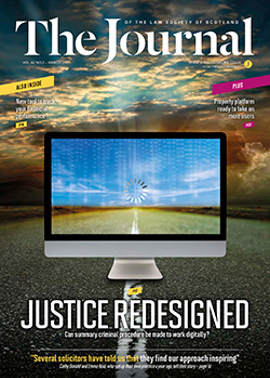Clear sky over summary courts

It is now almost four years since Lord Carloway, then Lord Justice Clerk, called for “clear sky thinking on how best to prove or disprove fact efficiently and in the interests of justice in the modern age, given the advances in technology which have occurred over the last 20 years”. Since then there has been considerable work undertaken, involving all parts of the justice sector, to apply some of that “clear sky thinking” to ways in which our criminal processes and procedures can be made more relevant to modern society, more efficient and likely to deliver the highest quality of justice.
Some of that work has fallen under the banner of the Evidence and Procedure Review (EPR), an SCTS-led programme looking at specific issues where technology might be applied to bring our criminal justice system more firmly into the 21st century.
The first paper published under the EPR banner was the Evidence and Procedure Review Report in March 2015. This was followed by Evidence and Procedure Review – Next Steps in February 2016. These papers looked specifically both at the way in which children and vulnerable witnesses are treated in the current system, and at the opportunities for a new approach to case management.
These themes have now developed into separate strands of work, one of which is to develop in greater detail a proposition for the redesign of summary criminal court procedure, to help tackle the issues of churn and delay we currently face. That strand has resulted in a third EPR proposition paper, published on 28 February 2017, entitled Evidence and Procedure Review: A New Model for Summary Criminal Court Procedure.
Drive against churn
This paper describes a model that would radically transform the way our summary criminal courts would work. It takes as its starting point an outline model that was set out in the earlier Next Steps report, and explores in some detail the possible paths a summary case might take in a more digitally enabled world.
Instead of a system heavily reliant on paper transactions, postal-based practices and bringing people together in a courtroom for procedural hearings, the model outlines how much of pre-trial case management could be conducted digitally.
At the heart of the proposition is the desire to combat the “churn” that plagues our summary courts at the moment. Too often court hearings don’t go according to plan for a variety of reasons – lack of preparation time, the late availability of CCTV evidence or of expert reports or the unavailability at key points of witnesses or the accused – and diets are postponed. This in turn causes inefficiency, expense to the public purse, and most significantly, stress and uncertainty about the progress of cases for victims, witnesses and the accused.
It is hoped that by embracing modern technology, and putting digital case management at the core of the summary process, many of these issues can be addressed.
Guiding rules
The model in the paper was developed through meetings of a working group of experienced professionals from across the justice system. This included two members of the Society’s Criminal Law Committee (who, like the other members, contributed in their personal capacity rather than as representatives of their organisation). The key propositions contained in the model are:
- As a general rule, all pre-trial procedure should take place as part of a digital case management process, involving the production of a digital timetable setting out key steps and deadlines in a summary case for both prosecution and defence. Court hearings should only be used for contested pre-trial preliminary pleas or case management issues.
- An intermediate diet and trial diet should not be allocated (and witnesses should not be cited) on the lodging of a not guilty plea as is the situation at present. Trial diets should only be allocated (and witnesses cited) after the case management process is complete. This should mean fewer witnesses, including police witnesses, are cited and inconvenienced.
- Strong judicial oversight of the case management process should be applied to bring about more agreement of evidence where possible, and to ensure summary trials focus on what is truly in dispute.
- In those cases in which guilty pleas are tendered, there should be the option for sentencing to be conducted digitally without the need for a court appearance on the part of the accused, but only if the sheriff or JP deems it appropriate.
The publication also makes it clear that it will be necessary for these propositions to be underpinned by the development of appropriate systems for storing and sharing evidence digitally, and for managing cases through the procedure.
Clearly the model being suggested would represent a major shift from the current system, and would require all those involved in criminal procedure – defence agents, prosecutors, police, judiciary, court staff – to adjust to a new way of working. The aim of the proposition is to seek agreement on those issues which are not in dispute at a much earlier stage of the proceedings, avoiding a late rush of preparation and agreement of joint minutes prior to the trial diet. The new approach would require proactive digital case management and agreement of evidence before a trial is allocated.
New flexibility?
This proposal would also transform the nature of the working day for all court professionals as, if the model works optimally, there would be a huge reduction in pre-trial in-court hearings. That will have implications for how and where professionals conduct their business – there will be fewer opportunities to meet with clients or to discuss issues with prosecutors within the confines of court buildings.
On the other hand, the new digital model would remove much of the rigidity from the system. The current system is founded on pre-allocated hearings on fixed dates requiring personal appearance and bringing all parties together. Instead of fixed dates and appearances, solicitors, prosecutors and the courts will be able to transact business digitally and much more expeditiously without being confined to 10am start times and long queues in busier courts.
One example of this under the ideas being put forward is that a straightforward guilty plea may take mere days to resolve. An accused person, in receipt of a summary complaint, could simply visit his/her solicitor in their office, whereupon the solicitor could view all the available evidence against the accused and, after discussion with the accused, simply make a plea digitally there and then. This would then be sent digitally to the fiscal to accept and then digitally to the court, which, if the sheriff or JP deems it appropriate, may apply a sentence of which the solicitor would be notified digitally. This can all be completed without a court hearing and in a relatively short turnaround from the service of the summary complaint. A return, perhaps to the original meaning of summary justice.
Such a move from a system of fixed hearings to more digital interaction cannot be taken lightly. Before the rules and finer details can be proposed, we must first be sure that the general proposition has the backing of the wider justice system. A critical element will be to get the system of legal aid right, so that it supports the changes that are being sought in a way that provides a sustainable business model for the profession going forward.
Evidence and Procedure Review: A New Model for Summary Criminal Court Procedure does not go into high technical detail or propose specific legislative changes at this time; it does however propose the core of what a new summary system might look like if it put modern technology and case management at the heart of the court process.
And it is in relation to this core model that your views are now sought.
This spring, SCTS will lead a series of discussion events around the country to hear views on the model. Details of these events will be published on the SCTS website in the coming weeks. Consultation is a vital part of the reform process and I would encourage you to be part of the dialogue on improving and modernising our summary criminal procedures.
If you cannot attend any of the discussion events, comments can be sent to the project team at: Evidenceandprocedurereview@scotcourts.gov.uk
Crown view
The Lord Advocate, James Wolffe QC, commented for the Journal:
“There is a compelling case for summary justice reform. The Evidence and Procedure Review Next Steps document (2016) recorded that approximately 52,000 summary trial diets are fixed each year, but only about 9,000 trials take place. This means that members of the public, in large numbers, are cited to trials which do not run, and implies significant inefficiency in the system. We need to change for the better the way that we do things.
“The New Model for Summary Court Procedure which SCTS has published is the fruit of collaborative work by a working group which has included members of the judiciary, the profession and the Crown. It demonstrates that there is an opportunity for transformational change. It shows what can be achieved when we work together to address a problem which we all recognise. There will now be an opportunity for all of us to consider further the proposals set out by SCTS; and I look forward very much to continuing to work with the profession, the Court Service and others as this important project is taken forward.”
In this issue
- Ineligibility – an open and shut case?
- Rent deposits – filling in the gaps
- EU at the crossroads
- Brexit: the human rights dimension
- Reading for pleasure
- Opinion: Andrew Lothian
- Book reviews
- Profile
- President's column
- Digital consultation closes
- People on the move
- Clear sky over summary courts
- Defence submissions
- Bookmark the benchmark
- GDPR: Practical steps for Scottish law firms to prepare
- Heads for business
- Spousal visas and the income rule
- Compete or get beat
- Platform party
- The consequences of excluding consequential loss
- Understanding the other side's position
- Family complexities
- Unitary patent: sunrise or sunset for UK holders?
- Third option
- Land reform, step by step
- Member against member?
- Scottish Solicitors' Discipline Tribunal
- Power of attorney update
- The 2012 Act: a bold step forward?
- Back to university
- Accreditation: calling regulatory lawyers
- Law reform roundup
- Street Law shows the way
- Year of big news
- De-risking email
- Paralegal pointers
- Ask Ash
- Top of the list
- Just your luck?
- Executries and pension overpayments






